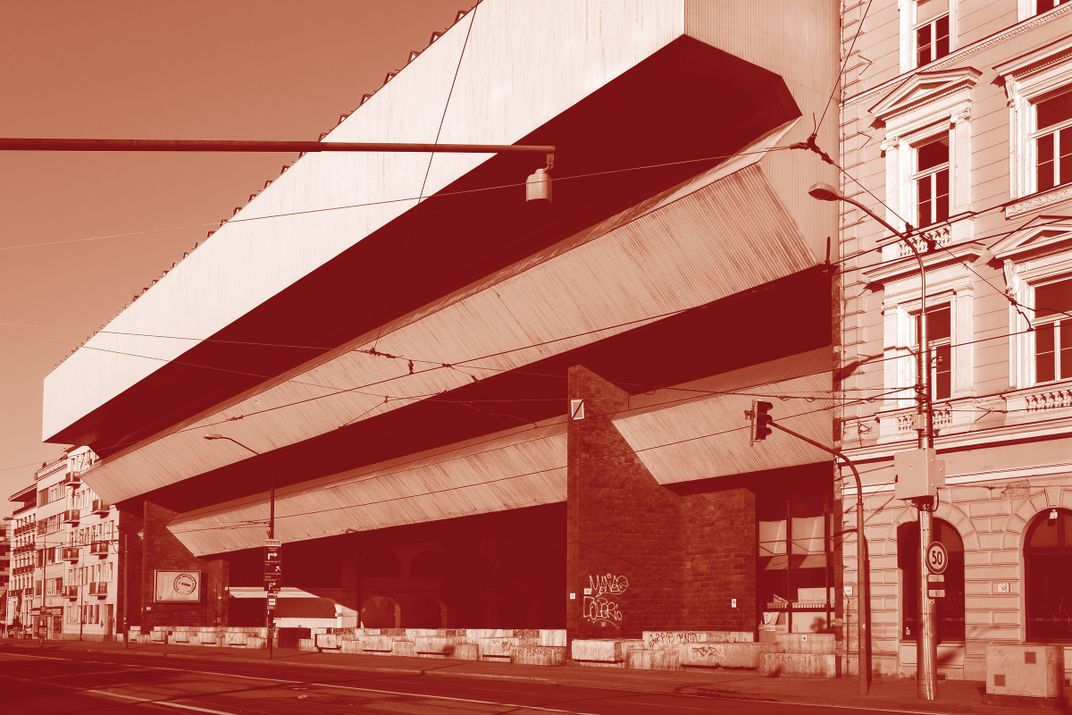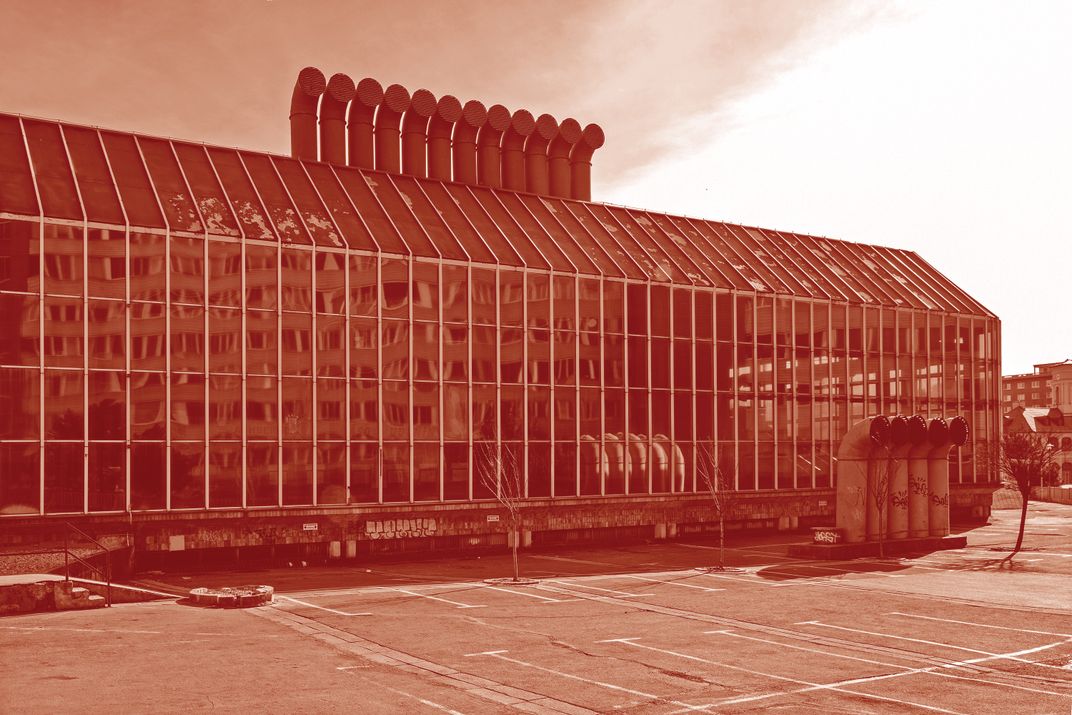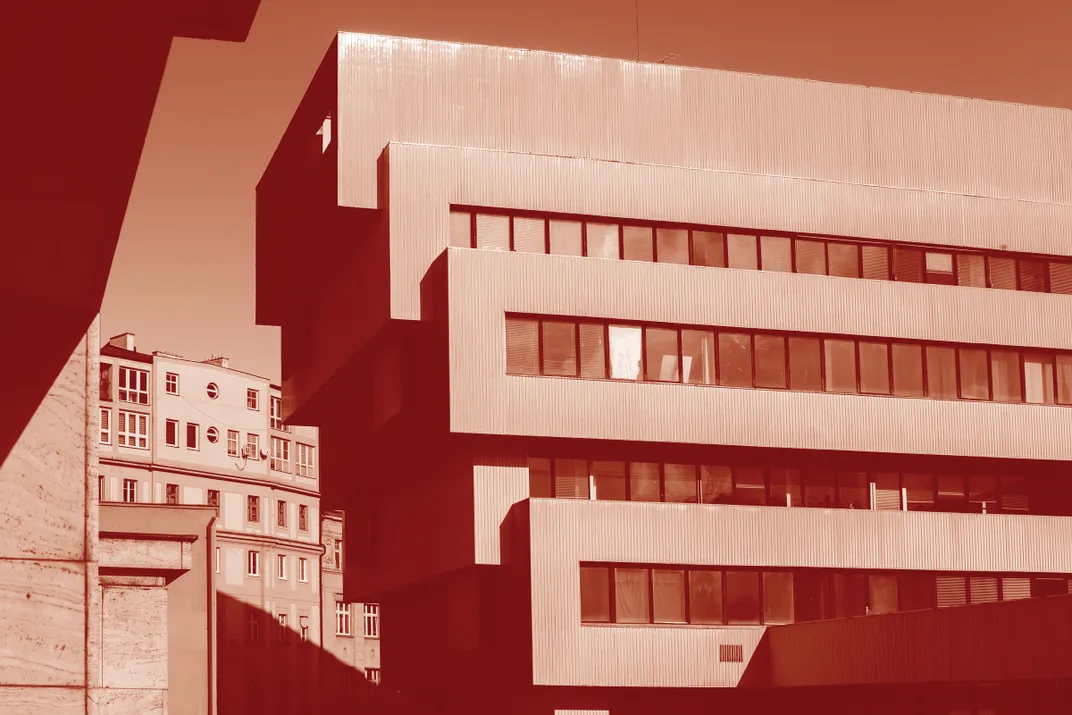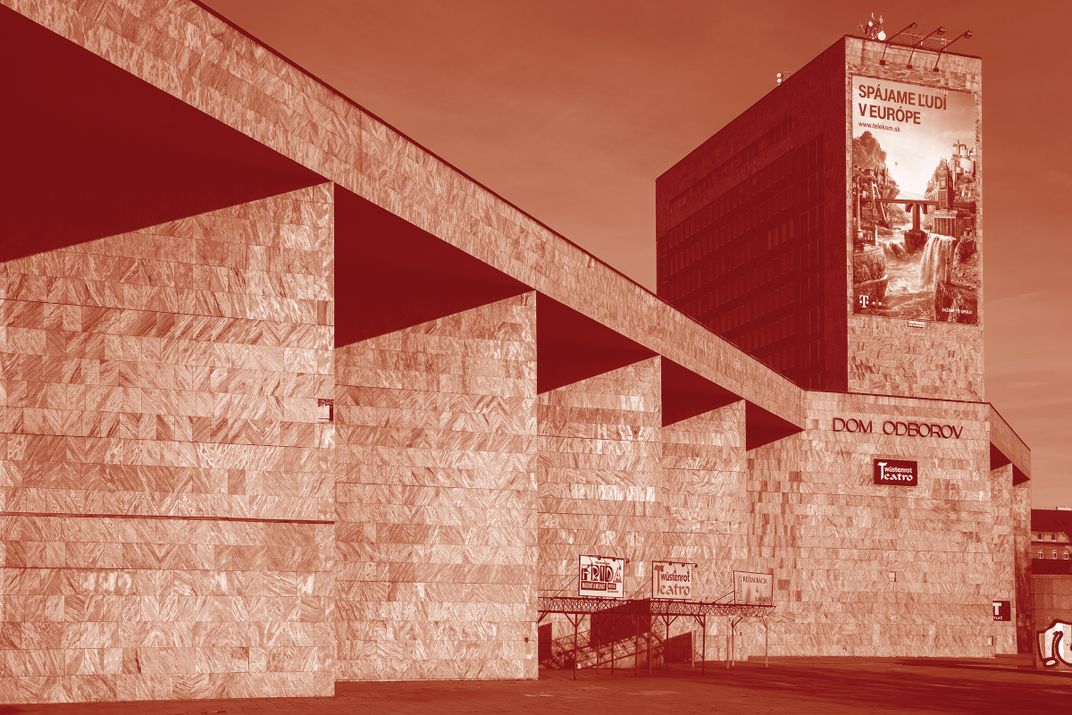Is Bratislava’s Communist-Era Architecture Worth Preserving?
For residents of Slovakia’s capital, Cold War structures recall a painful past
We seemed to be floating in space, hovering high over the Danube as we gazed out at the twin halves of Bratislava. To our left we saw needlelike church spires, cobblestone lanes, bulbous onion domes, and a hilltop castle. To the right stood a vast maze of massive apartment blocks that appeared to have been dropped next to a dense, green space. From our unusual perch on the Bridge of the National Slovak Uprising (or Most SNP in Slovak), my guide and I saw the broad river and a thin road hundreds of feet below over which tiny cars streamed like ants.
Anyone in those tiny cars would be forgiven for thinking that a silvery disk was landing on the bridge, as if it were a UFO from an old science fiction movie. Nor would it be strange to feel a vertiginous sense of distance and perhaps a frisson of fear while gazing at the odd construction.
But inside the bridge’s circular observation deck, the feeling was one of cheer and comfort. A DJ played tracks of chill-out music. Bartenders mixed fancy cocktails. A pleasant waitress arrived with our drinks, and we raised our glasses to the Slovak capital and the bizarre bridge we were visiting, part of the city’s highly unusual collection of communist-era buildings.
For most people in Bratislava, the city’s main attraction has to be its old town, whose baroque palaces and other historic buildings echo those of Vienna, Prague, and other nearby capitals. But for travelers from outside the country, Bratislava’s bridges, apartment blocks, and other constructions recalling the Soviet sphere of interest have a unique appeal. Occasionally quite refined despite their dehumanizing scale, the buildings combine elements of mid-century Scandinavian modernism, British brutalism, French post-modernism, and Stalinist pomposity. Some are truly beautiful. Others, like the 1973-built UFO bridge—officially the SNP but also known as Nový Most (New Bridge)—are truly weird. But Bratislava’s remarkable collection of planned-economy architecture is unlike almost anything else still standing in central Europe.
Despite this distinction, the buildings seem unloved by locals: In recent years, many of them have faced major redesigns, if not demolition. After gawking at some hard-to-believe photos in Eastmodern, a glossy, coffee-table book about Bratislava’s communist architecture, I took a high-speed train from Prague to see it firsthand.
A little over four hours later, I was staring up at a huge inverted pyramid rising almost 300 feet overhead. Known as the Slovak Radio Building, it includes a number of sound-insulated recording studios at its core, with outward-facing offices surrounding them on each floor. The edge of each rusty brown level extends far out beyond the one below it, and a crisscross network of supporting beams covers the facade with a heavy net. As a whole, it gives off a feeling of immense weight, which seems to push down on the entire neighborhood.
“One architectural blog called it one of the ugliest buildings in the world,” said my guide, Juro Sikora, who leads tours of Bratislava’s communist-era sites for Authentic Slovakia, a local company. “For people who believe in feng shui, this is the worst possible shape you can have.”
I didn’t know anything about feng shui, but staring at the pyramid I thought that there might be something to it. Although construction began in 1967, the building wasn’t completed until 1983, during the grim years that followed the liberal Prague Spring of 1968 when Soviet tanks had invaded Czechoslovakia, ending “socialism with a human face” and installing a decidedly less humane Communist Party government. The Velvet Revolution brought democracy to the Czech and Slovak peoples in 1989. Less than four years later, Slovakia and the Czech Republic split into separate countries. Every aspect of the radio building’s construction—from its oppressive heaviness to its rough surface—reflected the dark mood of its age.
Painful memories of four decades of communism make it hard for Bratislavans to appreciate the architecture, which is ‘‘slowly disappearing,” Juro said. “People don’t think these buildings are worth saving. First, they are not old enough. And [people] don’t feel very positive about that era.”
If I needed any evidence supporting that lack of respect, I found it at our next stop, the imposing Dom Odborov, or House of the Trade Unions—formerly known as the House of the Revolutionary Trade Union Movements, a sleek modern building with a flat, tiled façade and angled entrances covered with noisy signs for the businesses renting space inside. If I squinted and tried to ignore the visual pollution, I could see the building for what it was: a conference hall of the future as imagined in the late 1960s, like something from the original Planet of the Apes movies.
Saying goodbye to Juro, I decided to look for examples of Cold War architecture—or design—that contemporary Bratislavans actually liked. I grimaced when I spotted a modern taxi painted with the “VB” logo and colors from the hated verejná bezpečnosť, the onetime “public security” police force. Given the VB’s role in suppressing pro-democracy efforts, this apparent attempt at irony was off-putting, to say the least. I honestly couldn’t imagine any of my Czech or Slovak friends willingly getting into a VB car, taxi or otherwise. But later, at the cool lounge at the top of the UFO bridge, I realized that the Eastern bloc ethos in Bratislava could be playfully ironic without offending.
The next morning, I stopped at an artsy new cafe inside the prewar Dunaj shopping center, then took a taxi across the Danube to the sprawling Petržalka housing project—almost a city unto itself, home to some 120,000 residents living in identical apartment blocks whose construction began in 1977. The area has a tough reputation; today’s Slovak rap groups like to film music videos here.
But surprisingly, Petržalka turned out to be a highly livable neighborhood, pleasantly situated near the Danube and a beautiful green park, Sad Janka Kráľa, which dates from the late 18th century. Sure, the apartment blocks were repetitive, but many of them had been repainted in a variety of colors—bright red and yellow or blue and green—and the happy, young people pushing baby strollers and jogging along the river seemed anything but tough.
Back in Old Town, I met Mária Novotná, a friend of a friend, at the Slovak National Gallery, now under reconstruction. The sprawling museum combines three separate buildings: the Esterházy Palace, built in 1870; the neighboring baroque period barracks; and incongruously, a modern, top-heavy addition from 1977.
“People say that this new building destroyed the old building, but it did not—it allowed another public use for the old building,” Mária said. An architecture student, Mária was able to point out several nice touches of the addition, including a nearly hidden open-air cinema on one side, and offered to show me one of her favorite communist-era buildings near the city’s outskirts.
A few minutes later, she parked her car at the bottom of a wooded hill. Ahead of us, up a corkscrew path, stood a long, flat building as elegantly in sync with its surroundings as anything by Frank Lloyd Wright or Mies van der Rohe. It was a crematorium, Mária said, built in 1968 by the architect Ferdinand Milučký—an odd place to take a tourist, I knew, but a great choice for someone who was interested in unusual architecture.
Mária talked about some intricacies of its construction and noted that Bratislava was still trying to figure out what to do with such buildings. Did these reminders of a painful past all need to face the wrecking ball, simply because of when they were built? Should they stay?
“There is a discussion about monumental architecture and what does it mean to be a monument. Is it size? Is a monument a building that shows the power of architecture?” Mária looked at the building and nodded in admiration. “We don’t have the answer yet.”
Architecture tours
- Authentic Slovakia. Two-hour “post-socialist” city tour: €32 (roughly $35) per person
- Best Slovakia Tours. Two-hour Bratislava communist tour: €35 (roughly $38) per person
- e-Architect. Custom Bratislava architecture tours: prices vary
Planning Your Next Trip?
Explore great travel deals
Smithsonian magazine participates in affiliate link advertising programs. If you purchase an item through these links, we receive a commission.


/https://tf-cmsv2-smithsonianmag-media.s3.amazonaws.com/filer/a9/e7/a9e71f67-ab62-432a-94d9-feb2e63cddd2/sqj_1604_danube_bratis_05.jpg)

